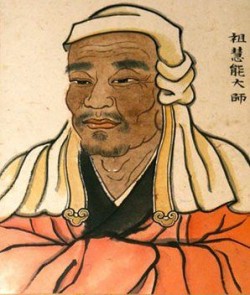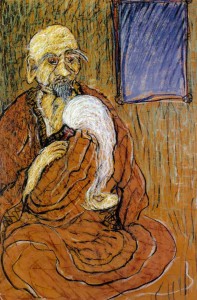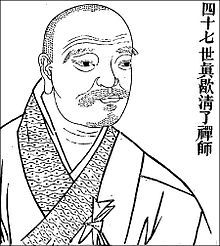Affliction is Enlightenment
 Linda Hoka Bebernes
Linda Hoka Bebernes
This article was written as a final paper for a Dharma Rain Zen Center Seminary class on the Chinese ancestors in our tradition. The assignment asked for an ancestor from each of the three periods of Chinese Ch’an identified in Andy Ferguson’s book on Zen’s Chinese Ancestors, “Legendary, Classical, and Literary.” Because it deals rather well with practical matters of daily life practice, we offer it here. – ed.
… affliction is enlightenment. One moment you’re deluded and a fool. The next moment you’re awake and a buddha. (Huineng[1])
In this paper, I will explore the concepts of “acceptance”and “non-attachment”by investigating the writings by three ancestors and teachers, Huineng[2], Shitou[3], and Hongzhi[4], spanning the Legendary, Classical, and Literary periods of Buddhism in China.
I will describe a pivotal experience in my practice that has brought me to a deeper understanding of “acceptance”and “non-attachment,”while highlighting excerpts from writings by these ancestors and teachers that seem to validate my personal experience. My aspiration is to follow Zen Master Keizan’s instructions:
…you should thoroughly examine learned knowledge and true realization, in order to arrive at the point where you can discern exactly which is which.[5]
**************
Working with contractors on house and yard projects invariably leads me to some sort of crisis. I will wake in the middle of the night in a state of full-blown anxiety over an unresolved issue or, even worse, a “wrong”decision that it seems too late to change.
Recently Kate and I worked on a joint project with our new neighbors to pull out an old concrete block fence on our property and replace it with a wood fence on their side. We needed to put in a retaining wall to account for a difference in level between their yard and ours. This piece of the project turned out to be more complicated than expected, requiring significant decisions to be made quickly as the work proceeded.
The night before concrete was to be poured for the retaining wall, I woke up about 4 am certain that the forms, which had already take hours longer to build than the contractor had anticipated, needed to be redone because a decision we had made the day before simply wasn’t going to work. “Should I tell the contractor to redo it? What will he think!”“Should I just passively let it go and live with the results?”“Why didn’t I ask for a few more minutes to consider before making that decision? I never ask enough questions.”“Well, I can’t do anything about it in the middle of the night. I should be able to just let it go and go back to sleep”…After lying awake long enough to know sleep wasn’t returning anytime soon, I got up and went to my cushion.
I turned my attention to the feelings and sensations arising…the tension in my body, the sick feeling in the pit of my stomach, my breath high in my chest, my shoulders hunched forward. As thoughts arose, I noticed how I would become caught by them, obsessing or elaborating on one and then another.
After I’d been sitting for a while, my body began to relax a bit and the tangle of thoughts in which I was entrapped loosen. As my perspective broadened, I began to recognize familiar thought patterns. Self criticism and “shoulds”were there in abundance as well as a familiar koan that comes up for me about when to assert myself vs. just to let it go. And I saw how an inclination I have to try to bring things to closure had led me to make a decision quickly before I’d thoroughly investigated other options.
I felt lighter and more open. I turned my attention back to the retaining wall issue. It was still there, but it no longer “grabbed and entrapped”me the way it did when I had first come to my cushion. I returned to bed and sleep.
This shift in perspective carried into the morning. As I prepared for the day, I felt anxious about the situation, but at the same time curious about how it would play out. When the contractor arrived to pour the concrete, rather than approaching him with solution in hand, I invited Kate to join me. We opened a friendly conversation with him, which led eventually to making some minor adjustments to the plan that addressed my concerns and allowed the project to proceed.
**************
This story portrays a lesson that I seem to need to revisit over and over.
If you don’t take refuge in your own nature, there is no other place of refuge. (Huineng[6])
The middling or lowly can’t help wondering;
Will this hut perish or not?
Perishable or not, the original master is present,
not dwelling north, south, east or west. (Shitou[7])
Even if you thoroughly understand, still please practice until it is familiar. (Hongzhi[8])
The reentry point for me each time is “acceptance”…pointing my attention toward the affliction, not denying it or trying to rationalize it away, but also not wallowing in it. It seems essential to simply accept that “OK this is the state I’m in now,”and sit with it (no matter how difficult).
Our nature contains the ten thousand dharmas. That’s how great it is. And the ten thousand dharmas are our nature. To see humans and non-humans, both the good and the bad, good dharmas and bad dharmas, without rejecting them and without being corrupted by them, this is to be like space. (Huineng[9])
Just sitting with head covered all things are at rest.
Thus, this mountain monk doesn’t understand at all.
Living here he no longer works to get free. (Shitou[10])
Facing everything, let go and attain stability. Stay with that just as that. Stay with this just as this. (Hongzhi[11])
Once I become tuned into what is happening in this moment, the next step seems to be to open up to investigating what’s going on, but without attachment to outcome. I often need to remind myself that this isn’t about looking for answers or finding a way to “fix”something about myself or the situation. Nor is it about looking for ways to feel calmer or make myself into a better person. If it can be put into words, it’s something more like aspiring to clearly see my nature.
Simply practice with a straightforward mind and don’t become attached to any dharma. (Huineng[12])
Who would proudly arrange seats, trying to entice guests?
Turn around the light to shine within, then just return. (Shitou[13])
Contemplating your own authentic form is how to contemplate Buddha. If you can experience yourself without distractions, simply surpass partiality, and go beyond conceptualizing. (Hongzhi[14])
For example, as a Myers-Briggs “J”type, I have an “action orientation”toward reaching closure and completion.[15] When the contractor asked me what I’d like him to do, my inclination was to quickly make a decision so he could move on with the project. As I investigated this situation from my cushion, it was tempting to tell myself that I would be experiencing less anxiety if I hadn’t jumped to a decision so quickly before considering more options, and that the “fix”for this in the future would be to learn to take the time to investigate options and more clearly understand implications before coming to closure.
Although this tendency toward closure is part of the “suchness”of “me”, it plays out differently in different situations. So, yes, situations are likely come up in the future where taking more time to make a decision would be appropriate. But in other situations, the ability to bring something to closure quickly may be quite useful. My aspiration is to simply notice this tendency in my nature as it plays out, while recognizing when I’m creating and becoming attached to thoughts (delusions) about it.
Those who realize this teaching do so through ‘no-thought,’ ‘no-memory,’ and ‘no-attachment.’ Don’t create a bunch of delusions. You yourself are the nature of suchness. View all dharmas with wisdom. Neither grasp nor reject them. This is the way to see your nature and become a buddha.(Huineng[16])
If you want to know the undying person in the hut,
Don’t separate from this skin bag here and now. (Shitou[17])
…you must completely withdraw from the invisible pounding and weaving of your ingrained ideas. If you want to be rid of this invisible [turmoil], you must just sit through it and let go of everything. Attain fulfillment and illuminate thoroughly, light and shadow altogether forgotten. Drop off your own skin, and the sense-dust will be fully purified, the eye readily discerning the brightness. Accept your function and be wholly satisfied. (Hongzhi[18])
Defining “who I am”in this way (“I’m a Myers-Briggs INTJ type”) is useful as a form. And, at the same time, it is a delusion held by the collective minds of those of us familiar with this paradigm, a mental construct describing an inclination that actually exists only in the context of a particular set of circumstances at a particular moment in time.
If I become attached to this form as an object or concept, thoughts about it will arise and obscure “reality”, “suchness”, or “what is truly so”in this moment.[19]
…this Dharma teaching of ours, both its direct and indirect versions, has proclaimed ‘no thought’ as its doctrine, ‘no form’ as its body, and ‘no attachment’ as its foundation.
What do we mean by a form that is ‘no form’? To be free of form in the presence of forms.
And ‘no thought’? Not to think about thoughts.
And ‘no attachment’, which is everyone’s basic nature? Thought after thought, not to become attached. Whether it’s a past thought, a present thought or a future thought, let one thought follow another without interruption. …Once one thought becomes attached, every thought becomes attached, which is what we call ‘bondage.’ But when you go from one thought to another without becoming attached to any dharma, there’s no bondage. This is why ‘no attachment’ is our foundation. (Huineng[20])
Let go of hundreds of years and relax completely. Open your hands and walk innocent. (Shitou[21])
All Buddhas and all minds reach the essential without duality. …Dignified without relying on others and radiant beyond doubt, maintaining this as primary, the energy turns around and transforms all estrangement. Passing through the world responding to situations, illumination is without striving and functions without leaving traces. From the beginning the clouds leisurely release their rain, drifting past obstacles. (Hongzhi[22])
Rather than tie up this paper with a neat closure, I am inclined to leave it open-ended for now. The two threads that I’m drawn to tug at next are “flow” and “interconnection.”
Flow intrigues me because it seems closely related to non-attachment and, also, because the image of unobstructed flow appears so frequently in the writings of these three ancestors/teachers.
Prajna means ‘wisdom.’…One thought of ignorance, and prajna stops. One thought of wisdom, and prajna reappears. … prajna has no form. It’s the nature of wisdom. And what does paramita mean? … ‘ what leads to the other shore,’ which means what transcends birth and death. When we are attached to objects, we give rise to birth and death, like when waves form on the water. This is what we mean by ‘this shore.’ When we are free of objects, there is no birth or death, like when a river flows on forever. So we say this ‘leads to the other shore’. (Huineng[23])
Daowu asked, “What is the great meaning of the Buddhadharma??
Shitou said, “Not attaining. Not knowing.”
Daowu asked, “Is there anything beyond this?”
Shitou said, “The sky does not obstruct the white cloud’s flight.”
(Shitou[24])
Follow the current and paddle along, naturally unobstructed. (Hongzhi[25])
Interconnection intrigues me because it is so much at the edge of my practice right now, both in the universal sense of realizing/experiencing/seeing/understanding the interconnectedness and interdependence of all being and in the particular sense of my evolving relationships with family, friends, community, and sangha.
The capacity of the mind is so great, it’s like space. …space has room for the sun and the moon and the stars, the earth and its mountains and rivers, every plant and tree, bad people and good people, bad teachings and good teachings, heavens and hells. All of this exists in space. The emptiness of our nature is also like this. (Huineng[26])
Though the hut is small, it includes the entire world.
In ten feet square, an old man illumines forms and their nature. (Shitou[27])
The white clouds are fascinated with the green mountain’s foundation. The bright moon cherishes being carried along with the flowing water. The clouds part and the mountain appears. The moon sets and the water is cool. Each bit of autumn contains vast interpenetration without bounds. (Hongzhi[28])
Bibliography:
Cleary, Thomas (translator), Transmission of Light (Denkoroku): Zen in the Art of Enlightenment by Zen Master Keizan, Shambala Publications, Boston MA, 1990.
Ferguson, Andy, Zen’s Chinese Heritage: The Masters and Their Teachings, Wisdom Publications, Somerville MA, 2011.
Leighton, Taigen Dan (editor and translator), Cultivating the Empty Field: The Silent Illumination of Zen Master Hongzhi, Tuttle Publishing, North Clarendon VT, 2000.
Red Pine (translation and commentary), The Platform Sutra: The Zen Teaching of Hui-neng, Counterpoint, Berkeley CA, 2006.
End Notes:
[1] Red Pine, page 21. Platform Sutra section #26.
[2] Dajian Huineng “Caoxi” (Daikan Eno), 638-713, sixth generation ancestor from the Legendary period. Author of The Platform Sutra.
[3] Shitou Xiqian (Sekito Kisen), 700-790, eighth generation ancestor from the Classical period. Author of the Song of the Grass Roof Hermitage.
[4] Hongzhi Zhengjue “Tiantong”(n.d.), twentieth generation teacher from the Literary period. Author of Cultivating the Empty Field.
[5] Cleary, page 134.
[6] Red Pine, page 20. Platform Sutra section #23.
[7] Leighton, page 72. From Song of the Grass Roof Hermitage.
[8] Leighton, page 33. From The Ground That Sages Cannot Transmit practice instruction.
[9] Red Pine, pages 20-21. Platform Sutrasection #25.
[10] Leighton, page 72. From Song of the Grass Roof Hermitage.
[11] Leighton, page 31. From Face Everything, Let Go, and Attain Stability practice instruction.
[12] Red Pine, page 11. Platform Sutrasection #14.
[13] Leighton, page 72. From Song of the Grass Roof Hermitage.
[14] Leighton, page 38. From How to Contemplate Buddha practice instruction.
[15] http://www.personalitypathways.com/type_inventory.html
[16] Red Pine page 22. Platform Sutrasection #27.
[17] Leighton, page 72. From Song of the Grass Roof Hermitage.
[18] Leighton, page 44. From Drop Off Your Skin, Accept Your Function practice instruction.
[19] Red Pine, page143. In his commentary, Red Pine suggests that these terms are interchangeable.
[20] Red Pine, page 12. Platform Sutrasection #17.
[21] Leighton, page 72. From Song of the Grass Roof Hermitage.
[22] Leighton, page 38. From How to Contemplate Buddha practice instruction.
[23] Red Pine, page 21. Platform Sutrasection #26.
[24] Ferguson, pages 82-83.
[25] Leighton, page 35. From The Ancient Ferryboat in Bright Moonlight practice instruction.
[26] Red Pine, page 20. Platform Sutrasection #24.
[27] Leighton, page 72. From Song of the Grass Roof Hermitage.
[28] Leighton, pages 41-42. From The Clouds’Fascination and the Moon’s Cherishing practice instruction.



